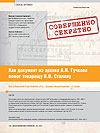On the Question of Driving Forces Behind the Creation in 1925 of a “Legal Mechanism for ‘Pushing’ Germany” to the East
DOI: 10.33917/es-5.197.2024.121-129
The article examines the driving forces that created, on the basis of the final documents of the Locarno Conference of 1925, the “legal mechanism for ‘pushing’ Germany to the East”. The actors in this process were located not only in Germany itself, but primarily outside its borders. The first group included a number of representatives of the ruling circles of Germany, in particular Chancellor Hans Luther and Foreign Minister Gustav Stresemann, as well as representatives of industrial and financial circles, led by the protégé of the thalassocratic bankers, the German financier Hjalmar Schacht. The second group should include a certain part of the ruling circles of England (Austen Chamberlain, Edgar Vincent D’Abernon, etc.), the USA (President Calvin Coolidge, etc.), and France (Prime Minister Aristide Briand, etc.). The most significant role was played by financiers — director of the Bank of England Montagu Collett Norman and director of the Federal Reserve Bank of New York Benjamin Strong.
References:
1. Mackinder H.J. Democratic Ideals and Reality. A Study in the Politics of Reconstruction. London, Constable and Company Ltd, 1919, 273 p.
2. Morozov S.V. K voprosu o sozdanii v 1925 g. pravovogo mekhanizma “podtalkivaniya” Germanii na Vostok [On the Issue of the Creation in 1925 of a
Legal Mechanism for “Pushing” Germany to the East]. Vestnik Tomskogo gosudarstvennogo universiteta, 2016, no 412, Noyabr’, p. 84–88, available at: http://
journals.tsu.ru/vestnik/&journal_page=archive&id=1482
3. Nikonova S.V. Germaniya i Angliya ot Lokarno do Lozanny [Germany and England from Locarno to Lausanne]. Moscow, 1966, 345 p.
4. Spaight J.M. Pseudo-Security. L. — N.Y. — Toronto, 1928, 177 p.
5. Foreign Relations of the United States. Vol. I. Washington, U.S. Government Printing Office, 1954, 1015 p.
6. D’Abernon, Viscount. Botschafter der Zeitwende. Bd. III. Leipzig, 1929–1930, 349 s.
7. Luther H. Politiker ohne Partei. Erinnerungen. Stuttgart, 1960, 437 p.
8. Lokarnskaya konferentsiya 1925 g. Dokumenty [Locarno Conference 1925. Documents]. Moscow, 1959, 512 p.
9. D’Abernon, Lord. An Ambassador of Peace. Pages from the Diary of Viscount d’Abernon. Vol. III. 1924–1926. London, 1930, 317 p.
10. Petrie Ch. The Life and Letters of the Right Honoured Sir Austen Chamberlain. Vol. II, London, 1940, 476 p.
11. Chicago Tribune. March 6, 1925.
12. World. May 10, 1925.
13. Dokumenty vneshney politiki SSSR [Documents of the USSR Foreign Policy]. Vol. VIII, Moscow, 1963, 864 c.
14. Times. March 19, 1925.
15. Peace in Our Time. Adresses on Europe and the Empire by the Right Hon. Sir Austen Chamberlain. London, 1928. 308 p.
16. New York Times. May 5, 1925.
17. Zimmerman L. Deutsche Aussenpolitik in der Ära der Weimarer Republik. Göttingen, 1958, 486 p.
18. New York Times. July 27, 1925.
19. New York Times. July 29, 1925.
20. New York Times. July 27, 1925.
21. Times. August 12, 1925.











